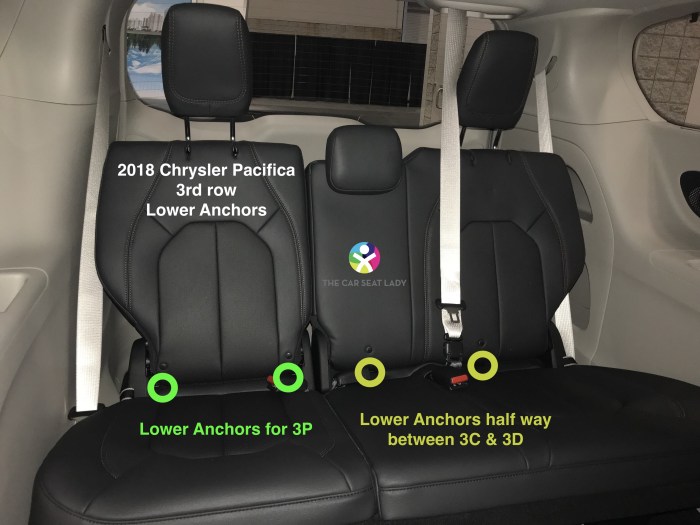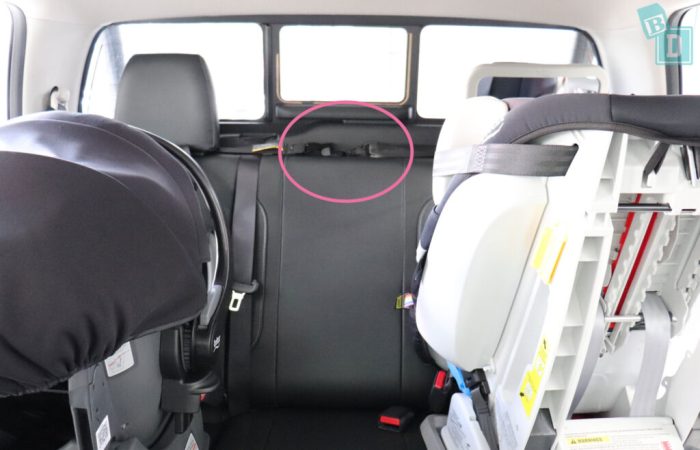Child car seat anchors for minivans: Seriously, it’s way more complicated than you think! Fitting your little one’s car seat safely isn’t just about slapping it in; it’s about understanding LATCH systems, tether anchors, and the quirks of different minivan models and years. This guide breaks down everything you need to know to keep your kiddo safe and sound on those long family road trips.
We’ll cover everything from finding those elusive anchors to troubleshooting tricky installations, ensuring a secure ride for your precious cargo.
This guide will walk you through the ins and outs of installing car seats in minivans, covering various car seat types, anchor locations across different minivan makes and models, and addressing common installation issues. We’ll also delve into safety regulations and best practices to ensure a secure and proper fit every time.
Minivan Compatibility
So you’re looking to install a child car seat in your minivan? Knowing the ins and outs of LATCH and tether systems is key for a safe and secure installation. This section breaks down minivan compatibility, focusing on LATCH anchor access and location variations across models and years.
Finding the right anchor points can sometimes feel like a scavenger hunt, especially with the variations between minivan makes, models, and even model years. Different manufacturers place LATCH anchors in various locations, and accessibility can differ significantly. This information aims to simplify the process and help you find the perfect spot for your child’s car seat.
LATCH and Tether System Compatibility Across Minivan Models
Most modern minivans are equipped with both LATCH (Lower Anchors and Tethers for Children) and tether anchor systems. However, it’s crucial to check your specific vehicle’s owner’s manual for confirmed compatibility and the exact locations of these anchors. The information below provides a general overview; always consult your manual for the most accurate and up-to-date details.
Ease of Access to LATCH Anchors
The ease of accessing LATCH anchors varies considerably across minivan models. Some manufacturers make them readily visible and easily accessible, while others might require some maneuvering or the removal of seatback covers. Factors such as seat design, trim level, and the presence of additional storage compartments can all impact access.
Variations in Anchor Locations Across Years and Trims
Anchor locations are not standardized across all minivan years and trims. A 2015 model might have its LATCH anchors in a different location compared to a 2023 model of the same make and model. Similarly, higher trim levels may include features (like additional storage) that affect anchor accessibility. Always consult your vehicle’s specific owner’s manual for the most accurate information.
Comparison of LATCH Anchor Positions in Popular Minivan Models
The table below offers a comparison of LATCH anchor positions for five popular minivan models. Remember that this is a general guideline, and individual vehicle specifications might vary. Always refer to your owner’s manual for precise details.
| Make | Model | Year | LATCH Anchor Location | Notes on Difficulty of Access |
|---|---|---|---|---|
| Honda | Odyssey | 2023 | Seat bottom and seatback | Generally easy access; may vary slightly depending on trim level. |
| Chrysler | Pacifica | 2022 | Seat bottom | Easy access, clearly marked. |
| Kia | Carnival | 2024 | Seat bottom and seatback | Access may be slightly more challenging in the third row. |
| Toyota | Sienna | 2023 | Seat bottom and seatback | Generally easy to reach; check for obstructions based on trim level. |
| Dodge | Grand Caravan | 2020 | Seat bottom | Access is generally straightforward. |
Child Car Seat Types and Anchor Usage

Choosing the right car seat and installing it correctly is crucial for your child’s safety. Minivans, with their ample space and various anchor points, offer flexibility, but understanding the different car seat types and how to utilize LATCH and tether systems is key. This section details the proper installation procedures for various child car seats in your minivan.
Different child car seats cater to different age and weight ranges. Understanding these differences and the appropriate installation methods is paramount for ensuring optimal safety. Incorrect installation can significantly compromise the effectiveness of the car seat in a collision.
Rear-Facing Car Seat Installation using LATCH
Rear-facing car seats are designed for infants and toddlers, generally up to a certain weight or height limit specified by the manufacturer. These seats face the rear of the vehicle, maximizing protection in a crash. The LATCH system (Lower Anchors and Tethers for Children) provides a convenient and secure method for installation.
Here’s a step-by-step guide to installing a rear-facing car seat using LATCH in your minivan:
- Locate the LATCH lower anchors in your minivan’s back seat. These are typically located between the seat cushions and the seatback, often marked with LATCH labels or symbols.
- Position the car seat on the vehicle seat. Ensure the car seat is firmly seated against the vehicle’s seatback.
- Connect the LATCH connectors from the car seat to the lower anchors in your minivan. Make sure the connectors are securely engaged.
- Tighten the LATCH straps. Pull the straps firmly until there’s minimal slack. You should not be able to move the car seat side-to-side more than one inch.
- Check for proper installation. Make sure the car seat is snug and secure against the vehicle’s seatback. Try to move the car seat side-to-side and forward and backward to ensure it is tightly secured.
Forward-Facing Car Seat Installation using LATCH and Tether
Forward-facing car seats are used for older toddlers and young children, again, up to the weight and height limits specified by the manufacturer. These seats face forward and require both the LATCH system and a tether strap for optimal security.
Visual Representation of Forward-Facing Car Seat Installation:
Imagine the car seat positioned correctly on the vehicle seat. The LATCH lower anchors are connected to the car seat’s lower connectors, located near the bottom of the car seat. These straps extend from the car seat and connect to the LATCH anchors located between the seat cushions and seatback. The tether strap, extending from the top of the car seat, is connected to the tether anchor located on the vehicle’s rear deck or behind the seat.
The tether strap should be pulled tight to secure the top of the car seat and prevent it from rotating forward in a collision. The straps should be taut, with minimal slack. The car seat should sit firmly against the vehicle seatback.
Booster Seat Installation
Booster seats raise the child to the proper height and position for the vehicle’s seatbelt to provide optimal protection. Booster seats typically don’t use LATCH, relying instead on the vehicle’s seatbelt. Proper installation involves routing the vehicle’s seatbelt correctly through the booster seat guides. Always consult the booster seat’s instructions and the vehicle’s owner’s manual for specific guidance.
Anchor Strength and Safety
LATCH (Lower Anchors and Tethers for Children) systems in minivans, while generally robust, aren’t all created equal. Understanding the strength and limitations of these systems, as well as the comparative safety of LATCH versus seatbelt installation, is crucial for ensuring your child’s safety. This section will explore these aspects and offer practical tips for secure car seat installation.The strength of LATCH anchors varies between minivan models and even across different model years of the same vehicle.
While there isn’t a published standardized strength rating readily available for individual LATCH anchors, the overall system is rigorously tested to meet federal safety standards. These standards ensure the anchors can withstand significant force in a crash, but the specific strength of each anchor is not publicly detailed by manufacturers. Instead, focus should be placed on proper installation and ensuring the car seat is securely fastened.
So, you’re looking at minivans and, like, totally stressing about finding the right car seat anchors? It’s a real pain, but way less stressful than thinking about the potential cost of replacing an EV battery, which is why checking out the details on EV battery replacement coverage 2025 is smart before you buy an electric vehicle. Back to those car seats though – make sure you check the LATCH system carefully before you buy any minivan!
Remember that the anchor’s strength is only part of the equation; the correct installation of the car seat itself is equally critical.
LATCH versus Seatbelt Installation: A Safety Comparison
Generally, LATCH is considered the preferred method for installing child car seats, particularly for rear-facing seats. LATCH systems offer a more straightforward and potentially less error-prone installation process, reducing the chance of improper seatbelt routing or slack. However, seatbelts, when used correctly, provide a safe alternative, especially for forward-facing car seats that exceed the weight limits of the LATCH system.
The key is to carefully follow the car seat manufacturer’s instructions for whichever method you choose. Both systems, if installed correctly, provide adequate protection in the event of a crash. Issues arise not from inherent differences in safety between LATCH and seatbelts, but from improper installation of either system.
So, you’re minivan-shopping, right? Making sure those child car seat anchors are top-notch is key. Before you even think about test driving, though, it’s smart to get pre-approved for an auto loan with a soft credit check, like you can do at Auto loan pre-approval with soft credit check , to know your budget. That way, you can focus on finding the perfect minivan with the safest car seat system for your little ones.
Challenges Posed by Difficult-to-Reach or Poorly Designed Anchors
Minivans, due to their design and often large interior space, can present challenges. Some minivans have LATCH anchors located in awkward positions, making it difficult to reach and securely connect the car seat. This can lead to improper installation and compromised safety. Poorly designed anchors, such as those that are too close together or too recessed, can also present difficulties.
For example, a parent might struggle to connect both lower anchors simultaneously if they are positioned too closely, resulting in an uneven or loose installation. Similarly, recessed anchors might make it hard to fully engage the connectors, leaving the car seat vulnerable in a collision. In such cases, using a seatbelt installation might be the safer and more practical option, provided the car seat’s instructions allow for it.
Tips for Secure Child Car Seat Installation in Minivans
Before installing the car seat, carefully review both the car seat’s and the minivan’s owner’s manuals. These manuals provide crucial information on proper installation procedures, weight limits, and anchor locations.
- Locate and Inspect Anchors: Thoroughly examine the minivan’s LATCH anchors or seatbelt system before starting. Ensure they are not damaged or obstructed.
- Proper Connection: Make sure the lower LATCH anchors or seatbelts are fully connected and locked. There should be no slack in the system.
- Tight Installation: Once connected, firmly tighten the car seat’s straps or the LATCH system according to the manufacturer’s instructions. The car seat should not move more than one inch side-to-side or front-to-back at the belt path.
- Use the Tether Strap: Always use the tether strap (if applicable and the car seat is forward-facing) to secure the top of the car seat to the minivan’s tether anchor. This significantly reduces the forward movement of the car seat in a collision.
- Regular Checks: Periodically check the car seat installation to ensure it remains secure and hasn’t loosened over time.
Troubleshooting and Problem Solving
Installing car seats in minivans, while generally straightforward, can sometimes present challenges. Understanding common issues and their solutions can save you time and frustration, ensuring your child’s safety. This section addresses typical problems encountered with LATCH and tether anchor systems, providing practical solutions to help you secure your car seat correctly.
Many issues stem from the minivan’s design or the specific car seat model. For example, tight LATCH straps, difficult-to-reach anchors, or incompatible car seat/minivan combinations are all fairly common. Addressing these problems effectively is crucial for a safe and secure car seat installation. Remember, a correctly installed car seat is your child’s best protection in a collision.
Tight LATCH Straps
Tight LATCH straps are a frequent complaint. The problem often arises because the lower anchors are recessed, making it difficult to fully extend and tighten the straps. This can leave slack in the system, leading to an insecure car seat installation.
- Solution 1: Try using a LATCH strap tightener. These tools provide extra leverage to pull the straps taut. Imagine a small, sturdy plastic device with a handle that grips the strap, providing a much better grip than your hands.
- Solution 2: If the anchors are difficult to reach, use a long, thin object (like a sturdy, flexible plastic tool, not a metal object that could scratch the interior) to help guide the straps into the anchor points. This can be particularly helpful in minivans with deep or narrow anchor slots.
- Solution 3: In some cases, the car seat’s LATCH connectors themselves might be the issue. Ensure the connectors are fully seated in the LATCH anchors and that no fabric is interfering with the connection.
Difficult-to-Reach Anchors
Minivans often have LATCH anchors located in hard-to-access areas, such as deep crevices between seats or under seat cushions. This makes it difficult to connect the LATCH straps and check for proper installation.
- Solution 1: Use a flashlight or a small mirror to help locate and see the anchors. This can dramatically improve visibility, especially in low-light conditions.
- Solution 2: Remove any obstructions, such as floor mats or cargo covers, that might be hindering access to the anchors. A clear path to the anchors is essential for a successful installation.
- Solution 3: If necessary, consult your minivan’s owner’s manual for diagrams showing the exact location of the LATCH anchors. The manual may offer tips on accessing them more easily.
Incompatible Car Seat/Minivan Combinations
Not all car seats are compatible with all minivans. Weight limits, anchor placement, and car seat design can create incompatibility issues. This can result in a car seat that is either impossible or unsafe to install using the LATCH system.
- Solution 1: Check your car seat’s and minivan’s manuals to confirm compatibility. These manuals usually provide specific details about weight limits, LATCH anchor locations, and any known compatibility issues.
- Solution 2: If LATCH installation is impossible or problematic, consider using the vehicle’s seat belt system to install the car seat. Always follow the car seat manufacturer’s instructions for seat belt installation.
- Solution 3: If you’re still having trouble, contact the car seat manufacturer or a certified Child Passenger Safety Technician (CPST) for assistance. CPSTs are experts in car seat installation and can offer personalized guidance.
Checking for Proper Installation and Regular Checks
After installing the car seat, it’s crucial to check for proper installation and conduct regular checks. A loose or improperly installed car seat can significantly reduce its effectiveness in a crash.
- Proper Installation Check: Ensure the car seat is securely fastened, the LATCH straps are taut, and there’s no excessive movement. The car seat should be firmly in place and not shift easily.
- Regular Checks: Inspect the car seat installation regularly, especially after a car wash or if the car has been involved in a minor collision. Check for any looseness or damage to the LATCH system or the car seat itself.
Troubleshooting Guide for Common LATCH and Tether Installation Problems
This guide summarizes solutions for common LATCH and tether installation issues.
- Problem: LATCH straps are too short. Solution: Use a LATCH strap tightener or try different anchor points if available.
- Problem: LATCH anchors are difficult to reach. Solution: Use a flashlight or small mirror; remove obstructions.
- Problem: Tether strap is too long or too short. Solution: Adjust the tether strap to the correct length, ensuring the car seat is stable. Consult your car seat and vehicle manuals.
- Problem: Car seat is wobbly or moves easily. Solution: Re-tighten the LATCH straps and/or the tether strap. Check for any obstructions hindering a secure fit.
- Problem: Car seat doesn’t fit properly in the vehicle. Solution: Verify compatibility with the vehicle and car seat manuals. Consider using the vehicle’s seat belt system.
Regulations and Standards

Keeping your little ones safe in minivans requires understanding the complex web of regulations and standards governing child car seat anchors. These rules aren’t just arbitrary; they’re the backbone of ensuring compatibility and safety across various minivan models and car seat brands, minimizing the risk of improper installation and potential injury. This section will delve into the specifics of these regulations and how they work to protect children.
The safety and compatibility of child car seats are primarily addressed through a combination of federal regulations and industry standards. These standards define the strength requirements for the lower anchors and tethers, the placement and design of these anchors, and the testing procedures used to verify compliance. International variations exist, leading to some differences in specific requirements and testing methodologies, but the overarching goal remains consistent: to provide secure and reliable systems for installing child restraints.
United States Federal Motor Vehicle Safety Standards
In the United States, the National Highway Traffic Safety Administration (NHTSA) sets the standards for child restraint systems and their anchorage points in vehicles. These standards, part of the Federal Motor Vehicle Safety Standards (FMVSS), specify requirements for Lower Anchors and Tethers for Children (LATCH) systems, which are the most common type of anchoring system found in modern minivans.
FMVSS also dictates the strength and durability requirements for these anchors, ensuring they can withstand the forces involved in a crash. Compliance with these standards is mandatory for all new vehicles sold in the U.S. Failure to meet these standards can result in significant penalties for manufacturers.
European Union Regulations
The European Union (EU) has its own set of regulations concerning child car seats and vehicle anchorage systems, often referred to as i-Size. While the underlying principles are similar to those in the U.S., the specific test methods and requirements may differ. For example, i-Size often focuses on the use of ISOFIX, a system similar to LATCH, but with slightly different anchor point specifications.
Compliance with these EU regulations is necessary for vehicles sold within the EU market.
Comparison of US and EU Standards
While both the U.S. and EU aim for the same outcome – safe child restraint systems – differences exist in their approaches. The U.S. relies heavily on LATCH, while the EU promotes i-Size, although both systems often have overlapping features. Testing methodologies and specific strength requirements may also vary, reflecting different engineering practices and priorities.
These variations highlight the complexities of international standards harmonization in the automotive safety field.
Impact of Standards on Minivan Compatibility, Child car seat anchors for minivans
The existence of these standards, despite some regional differences, significantly improves minivan compatibility with child car seats. By setting minimum requirements for anchor strength and placement, these standards create a baseline level of compatibility, making it easier for parents to safely install car seats across different minivan makes and models. This standardized approach minimizes confusion and promotes safer practices, regardless of the specific minivan brand or the child car seat manufacturer.
Final Review: Child Car Seat Anchors For Minivans
So, there you have it – a deep dive into the sometimes-confusing world of minivan car seat installation. Remember, a properly installed car seat is the best protection for your little one. Don’t hesitate to double-check your work, consult your car’s manual, and if you’re still unsure, get a professional inspection. Keeping your kids safe is the ultimate priority, and a little extra effort here goes a long way.
Happy travels!









